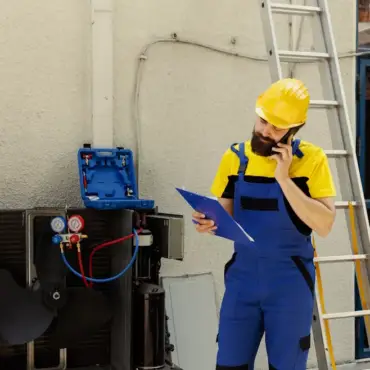It’s always best to look through the eyes of the potential customer to see if your idea has real merit. After all, if the idea doesn’t resonate with your intended audience, it was dead before it even got started.
For example, if you launched an advanced air filtration system but didn’t see the interest you expected, it could be that homeowners weren’t educated on the benefits, or they simply didn’t perceive cleaner air in their home as a priority.
Did internal systems support the change? Well-defined systems minimize chaos. Oxford defines chaos as complete disorder and confusion; behavior so unpredictable, it appears random. If your internal processes aren’t ready to support the new service, it’s sure to fail.
For example, if you invested in a new sales proposal presentation system expecting to reduce stress, increase average sales price, improve closing rates, and sell more jobs, but you experienced poor results, it might not be the system that failed, but rather your team’s attitude, preparedness or the lack of thorough training.
Was the new service adequately marketed? If no one knows about your new service, it’s destined to fail. If you rolled out a new maintenance program but didn’t see the uptake, it’s worth reviewing whether your customer outreach efforts were adequate.
Did you educate your homeowners about the benefits? Is there understandable information on your website or brochures? Were your techs trained to talk about it during repair calls? Was there a follow-up process in place for promoting the program after the first service?
Was there customer buy-in? Sometimes, services fail simply because they don’t resonate with your target audience. Remember this – customers are unlikely to invest in solutions for problems they don’t perceive as affecting them.
For example, you might have launched a premium maintenance plan with all the bells and whistles, but customers weren’t interested because they didn’t see the value compared to your basic “fix it when it breaks” services. In this case, the issue isn’t the service itself but perhaps the way it was presented.
Learn from the Data
Once you’ve identified why a particular service didn’t work, you need to rely on data to guide your next steps. Take the time to gather and analyze relevant metrics. As my friends at NCI say, “if you don’t measure, you’re just guessing!”
Questions to consider:
- What percentage of your customers signed up for the new service?
- Were there common characteristics among those who did or didn’t?
- Did the service drive repeat business, higher margins, or improved customer satisfaction?
- Did your internal processes (sales scripts, dispatching, training, etc.) align with the service’s goals?
If your sales team didn’t effectively promote the service, analyze their feedback. Did they feel they had the right tools or incentives to push it? Did they receive any feedback from customers that could explain the low interest? The answers lie in the data, and it’s essential to identify patterns before making any conclusions.
Take Corrective Action: Adjust, Don’t Abandon
Once you’ve identified the root causes, it’s time to adjust. The key here is to understand that corrective action doesn’t always mean abandoning the service or initiative altogether. Often, small tweaks can make a big difference.
Reposition the Service
If you realize that a service didn’t resonate with your target audience because of how it was marketed, consider repositioning it.
For example, if your air filtration service didn’t gain traction, you could reframe it as part of an overall health and wellness offering, emphasizing benefits like allergy relief, reduced illness, and better indoor air quality.
Improve Training and Support
Sometimes the service itself is sound, but your team wasn’t equipped to execute it properly. Offering more training for your team can make all the difference. Consider running role-play scenarios where they can practice pitching the service, answering customer questions, and overcoming objections.
Adjust Pricing or Packages
If price was a barrier to entry, consider adjusting your pricing strategy. You could offer a basic version of the service at a lower price point or create bundled packages that combine popular services with the underperforming ones to increase perceived value.
Double Down on Marketing
If the failure was a result of poor visibility, invest in stronger marketing efforts. Use email campaigns, social media, and in-person discussions during service calls to ensure that customers understand the value of the service. Consider offering introductory discounts to encourage first-time buyers and use positive customer testimonials to build credibility.
Set Realistic Goals for the New Year
As you plan for the upcoming year, set realistic, measurable goals based on the lessons you’ve learned. These goals should be SMART (Specific, Measurable, Achievable, Relevant, Time-bound).
For example, if your goal is to grow a maintenance program that struggled in the previous year, your target could be: “Increase maintenance plan sign-ups by 25% within the first quarter by implementing a new marketing strategy and offering additional training to all technicians.”
Continuously Evaluate and Adapt
Learning from the past year doesn’t end when the new year begins. To still be competitive, contractors need to continuously evaluate the effectiveness of their services, marketing efforts, and internal processes throughout the year.
This means creating a feedback loop where you regularly check in on performance metrics, listen to team and customer feedback, and make data-driven adjustments on an ongoing basis.
Failures as Opportunities
Every failure is an opportunity to gain experience, and as an HVAC contractor, you have the advantage of a cyclical business where each year brings new challenges and opportunities. By critically analyzing why certain initiatives didn’t work, making strategic adjustments, and setting realistic goals, you can leverage your past year’s experiences to set yourself up for success in the upcoming year. The key is to remain flexible, data-driven, and open to change, ensuring that every setback becomes a stepping stone toward long-term success.
Whether you require installation, repair, or maintenance, our technicians will assist you with top-quality service at any time of the day or night. Take comfort in knowing your indoor air quality is the best it can be with MOE heating & cooling services Ontario's solution for heating, air conditioning, and ventilation that’s cooler than the rest.
Contact us to schedule a visit. Our qualified team of technicians, are always ready to help you and guide you for heating and cooling issues. Weather you want to replace an old furnace or install a brand new air conditioner, we are here to help you. Our main office is at Kitchener but we can service most of Ontario's cities
Source link



